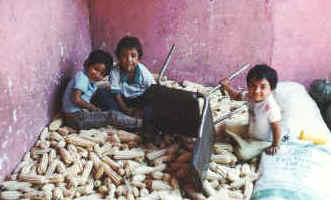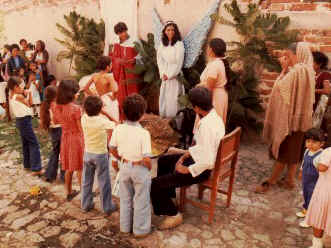 What is this minimum standard of consumption? In the first place, annual production in agricultural societies has to include what Eric Wolf called a "replacement fund": seed corn has to be put by for the next sowing, and tools or draft animals may need to be replaced. So some part of present production goes towards reproducing the conditions for future production. One of the most obvious indicators of crisis in peasant communities is when people eat their seed corn and slaughter their animals.
What is this minimum standard of consumption? In the first place, annual production in agricultural societies has to include what Eric Wolf called a "replacement fund": seed corn has to be put by for the next sowing, and tools or draft animals may need to be replaced. So some part of present production goes towards reproducing the conditions for future production. One of the most obvious indicators of crisis in peasant communities is when people eat their seed corn and slaughter their animals.
There is, however, something else that we have to take into account in defining minimum standards of consumption as well as the replacement fund. As Sahlins puts it, human beings do not simply have to ‘provision’ their bodies: they also have to ‘provision’ their social relationships. Marriage and other social rites de passage involve additional household production. So peasant households can only reproduce themselves as social entities over time by producing a little extra to satisfy their social obligations. We might call this a ‘social reproduction’ fund. In practice, the amount of resources dedicated to social expenditures which are obligatory in a peasant community may be a very significant proportion of the community's total production. Fiesta sponsorship in Latin America may, for example, cost a man the equivalent of a whole year's income. But not all household production of surplus is to do with meeting household obligations in communal social life. In the case of peasants, the most significant social cause of surplus production is the fact that peasants are obliged to pay taxes to the state and rent or other dues to landlords, churches and other ruling class institutions. A basic dilemma facing peasants is how they can continue to make a basic livelihood for themselves given all these other demands upon them to produce surpluses for dominant groups in a larger society.
 Chayanov noted that peasants responded to these problems by doing things that appeared to be perverse by the standards of capitalist economics. They might, for example, produce more when prices fell, which is hardly good business. For Chayanov, the key to understanding the peasant farm was the fact that it was a unit of consumption as well as a unit of product, and that it did its producing by using family labour. This, he argued, enabled the peasant farm to behave in ways that made no sense to capitalists but made good sense to peasants.
Chayanov noted that peasants responded to these problems by doing things that appeared to be perverse by the standards of capitalist economics. They might, for example, produce more when prices fell, which is hardly good business. For Chayanov, the key to understanding the peasant farm was the fact that it was a unit of consumption as well as a unit of product, and that it did its producing by using family labour. This, he argued, enabled the peasant farm to behave in ways that made no sense to capitalists but made good sense to peasants.


 What is this minimum standard of consumption? In the first place, annual production in agricultural societies has to include what Eric Wolf called a "replacement fund": seed corn has to be put by for the next sowing, and tools or draft animals may need to be replaced. So some part of present production goes towards reproducing the conditions for future production. One of the most obvious indicators of crisis in peasant communities is when people eat their seed corn and slaughter their animals.
What is this minimum standard of consumption? In the first place, annual production in agricultural societies has to include what Eric Wolf called a "replacement fund": seed corn has to be put by for the next sowing, and tools or draft animals may need to be replaced. So some part of present production goes towards reproducing the conditions for future production. One of the most obvious indicators of crisis in peasant communities is when people eat their seed corn and slaughter their animals. Chayanov noted that peasants responded to these problems by doing things that appeared to be perverse by the standards of capitalist economics. They might, for example, produce more when prices fell, which is hardly good business. For Chayanov, the key to understanding the peasant farm was the fact that it was a unit of consumption as well as a unit of product, and that it did its producing by using family labour. This, he argued, enabled the peasant farm to behave in ways that made no sense to capitalists but made good sense to peasants.
Chayanov noted that peasants responded to these problems by doing things that appeared to be perverse by the standards of capitalist economics. They might, for example, produce more when prices fell, which is hardly good business. For Chayanov, the key to understanding the peasant farm was the fact that it was a unit of consumption as well as a unit of product, and that it did its producing by using family labour. This, he argued, enabled the peasant farm to behave in ways that made no sense to capitalists but made good sense to peasants.